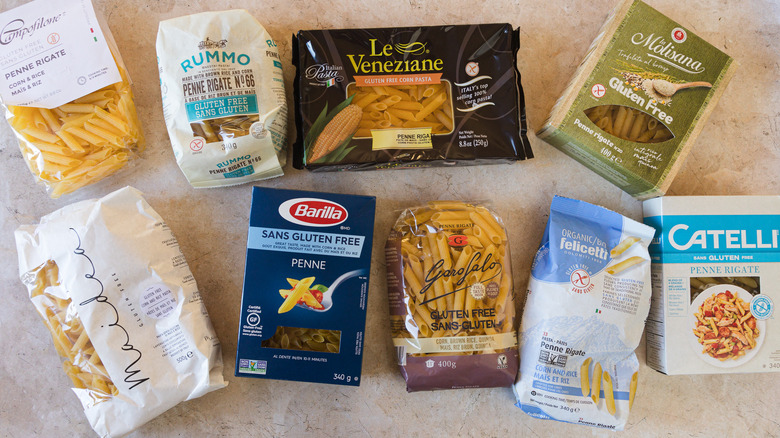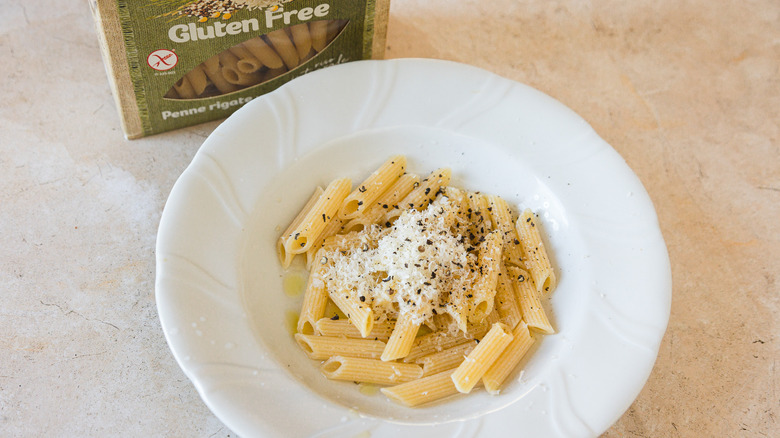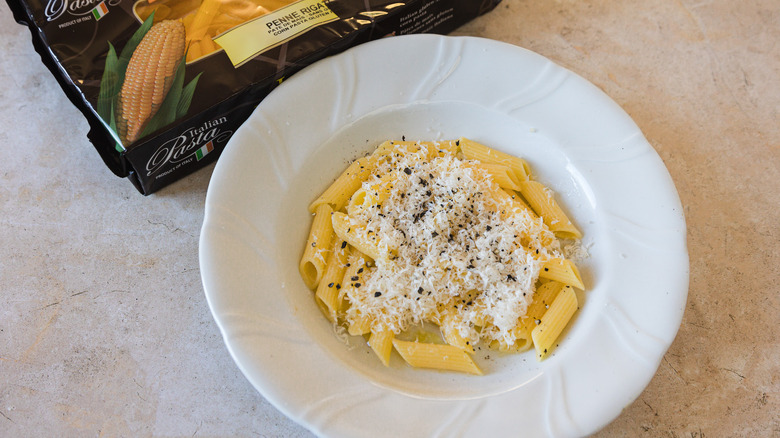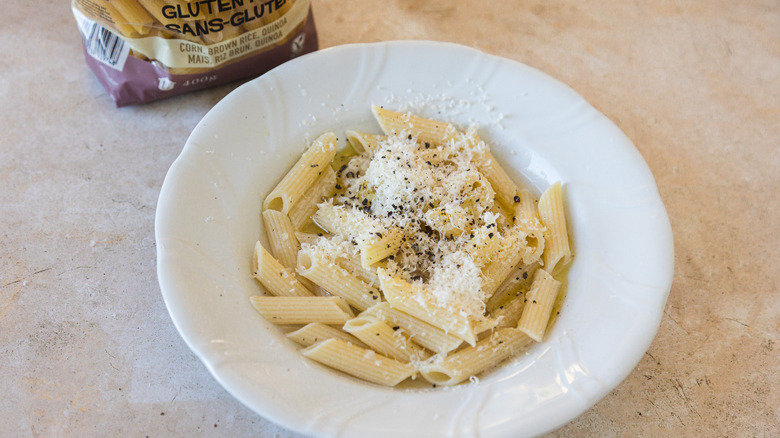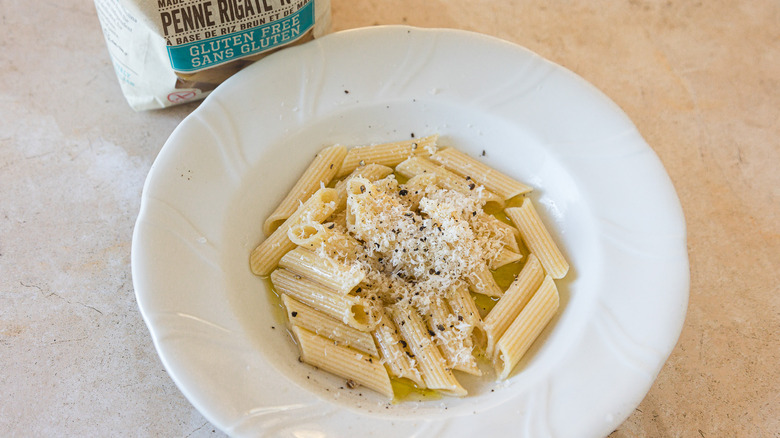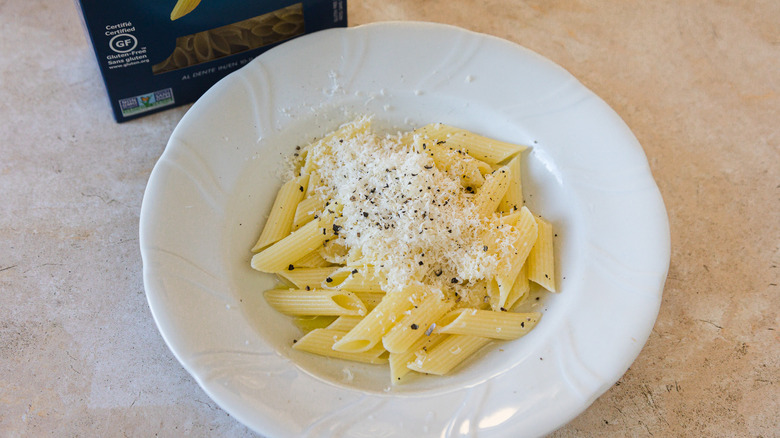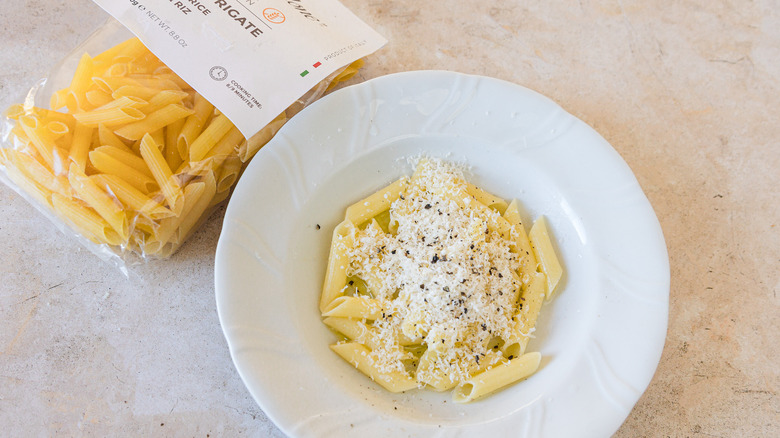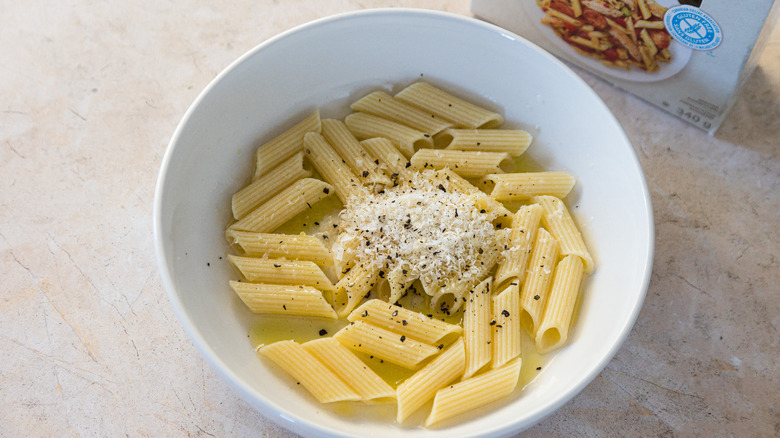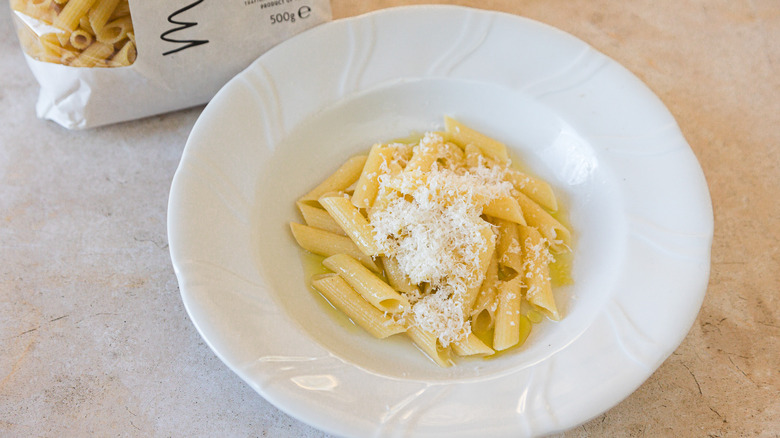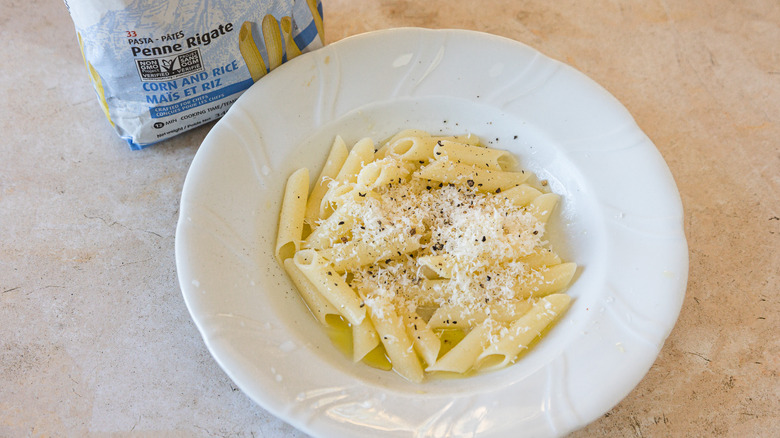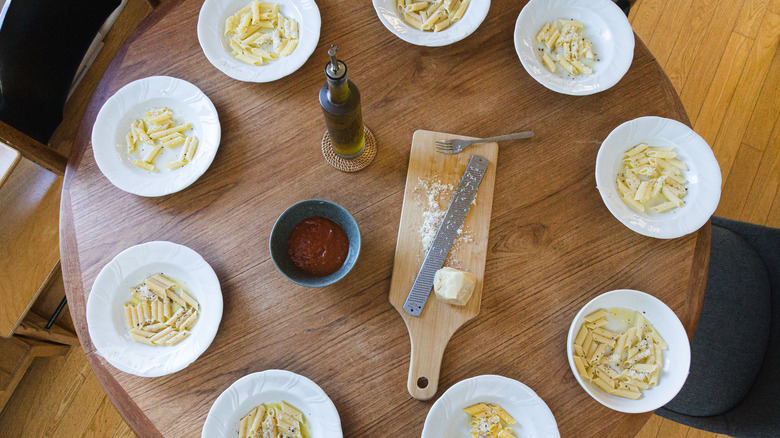Gluten-Free Pasta Brands, Ranked Worst To Best
We may receive a commission on purchases made from links.
Gluten-free pasta has come a long way in recent years, evolving from being the purview of fringe hippies to a common staple for those with celiac disease, gluten sensitivities, and anyone looking to reduce their gluten intake. As demand has grown, so has the quality of these products, with many now rivaling traditional wheat pasta in taste and texture.
Traditional Italian pasta is usually made from durum wheat semolina, ground coarsely and mixed with water or eggs into a thin dough. It is then flattened and shaped into myriad pasta shapes, all of which have some meaning and myth behind them. Modern gluten-free pasta, however, is made from a variety of grains and legumes, including brown rice, corn, quinoa, chickpeas, and lentils. It comes in a more limited number of shapes, with spaghetti and penne topping the list of most brands. These pasta alternatives not only mimic wheat pasta, but in some cases, they also aim to offer unique flavors and nutritional benefits. For instance, legume-based pastas often have higher protein and fiber content than their wheat counterparts.
With numerous options available, choosing the right gluten-free pasta can be overwhelming, causing some to just reach for that rice paper instead — that's where our article comes in. With more than 10 years of experience as gluten-free cook, baker and recipe developer for At the Immigrant's Table, I've had my fair share of good and pasta gluten-free pasta. For this article, I've gathered a group of four taste testers of mixed ages who sampled and evaluated nine prominent gluten-free pasta brands, ranking them from worst to best. Our goal is to help you navigate the gluten-free pasta aisle with confidence, ensuring your next pasta dish doesn't turn out as inedible cardboard, or prison mush.
9. Molisana
At the bottom of our list is Molisana. Molisana's gluten-free penne has a white-yellow color that is similar to traditional wheat pasta. However, that's where most similarities end. Its thick dough and pronounced ridges suggest it can handle hearty sauces, but make it really hard to chew and enjoy. The pasta offers a good, but very strong flavor, and its hard texture might be too much for some. This penne seems best suited for dishes with strong, chunky sauces that can match its sturdy structure. While not the most versatile option, Molisana's gluten-free penne could satisfy those who prefer a firmer, more substantial pasta experience. However, we won't be going back for this one, despite the fact it's one of the more affordable gluten-free pastas around.
8. La Veneziane
La Veneziane's gluten-free penne stands out with its vibrant yellow color, which clearly hints at its founding grain — corn. The pasta noodles are short, and their medium grooves provide a balance between smooth and ridged textures. When cooked, this penne becomes very chewy, which might appeal to al dente pasta lovers, but was a turn off for our taste testers. Its thickness suggests it could hold up well to hearty sauces like bolognese. However, its robust flavor, texture and color will overpower delicate flavors, making it clash with lighter, seafood-based dishes. Veneziane offers an interesting choice for those seeking a distinctly corn-flavored, toothsome gluten-free pasta, but it is far from being our first — or even second — choice.
7. Garofalo
Garofalo's gluten-free penne features very thick walls and strongly pronounced grooves, giving it a substantial presence. The pasta had one of the strongest flavors among those tested, likely due to its composition of corn, quinoa, and brown rice. This pronounced taste could complement robust, vegetable-heavy sauces with a pronounced flavor that can withstand against the grains. The hard texture and deep ridges suggest this pasta would excel in chunky, flavorful gluten-free pasta recipes. While not the most versatile option, Garofalo's offering could please those who enjoy a more assertive pasta experience in their gluten-free dishes. As an Italian brand that is mostly available in specialty boutiques, however, this pasta also costs a pretty penny, making it a bit less accessible. The brand also has a few special pasta shapes in its gluten-free arsenal, like artisanal rolled casarecce, offering options for those willing to splurge.
6. Rummo
Rummo has become one of the most popular gluten-free Italian brands around, and for good reason. It offers a variety of shapes, including large-sized mezzi rigatoni and star-shaped stelline pasta. It has an average price point, making it fairly accessible — but not enough to make it past the halfway point of our list. Rummo's gluten-free penne rigate has a clean, whitish appearance similar to traditional wheat pasta. Its hard texture and pronounced grooves provide a satisfying bite and suggest good sauce-holding capacity. The pasta itself has a bland and neutral flavor profile, allowing it to act as a canvas for sauces to shine. The texture balances firmness and tenderness, making it versatile for various dishes. However, it was just a bit too hard for our liking at the recommended al dente cooking time, which meant it was just shy of the typical texture for Italian pasta. Rummo's offering seems well-suited for those who want their gluten-free pasta to closely mimic traditional pasta, albeit a very hard one.
6. Barilla
Landing smack dub in the middle of our list is Barilla, one of the most common — and cheapest — gluten-free pasta brands around. Despite our best intentions not to love it, Barilla delivered a perfectly reliable and even decent gluten-free penne. The Barilla penne has a notably white, almost anemic color. It cooked the fastest among the brands tested, with a 10-minute cooking time yielding very soft pasta that verged on falling apart. The medium grooves provide some texture, although the overall softness might concern those preferring firmer pasta. Its quick cooking time and tender result position this as an everyday pasta option, suitable for busy weeknight meals. While it may not hold up to robust sauces, its softer texture could appeal to those who prefer a more delicate pasta experience or for dishes with lighter sauces.
4. Campofilone
Coming in at number three, Campofilone's gluten-free penne offers a delicate yet substantial egg pasta experience. Its thin ridges, almost smooth surface, and yellow-white color create an authentic look that would hold its own in any blind taste against a well-crafted Italian penne. The texture is chewy and springy, resisting the fork while maintaining integrity. This combination of delicacy and resilience makes it perfect for various sauces and dishes. The pasta's ability to hold its shape suggests good performance in both light and substantial recipes. Campofilone's offering seems to balance authenticity and adaptability, making it a strong contender for those seeking gluten-free pasta that closely mimics traditional wheat pasta. It also has a variety of specialty pasta shapes available for gluten-free diners, but these can be extremely hard to source outside of specialty boutiques.
3. Catelli
The further you go up our list, the more expensive the pasta gets...with this notable exception. One of the cheapest gluten-free pastas to source, Catelli's gluten-free penne nonetheless ranked really well with our adult and child taste testers. This noodle has a classic appearance, with a white color and very pronounced ridges. The pasta is notably thick, suggesting a substantial bite and good sauce-holding capability due to its pronounced ridges. Its neutral flavor adapts well to various sauces and ingredients without overpowering other flavors. This pasta's versatility and neutral profile make it suitable for a wide range of recipes, from light olive oil-based dishes to heartier meat sauces. Catelli's offering balances texture and adaptability, and a very neutral flavor that makes it an easy and affordable choice to reach for when you just want a weeknight pasta dish to feed the family.
2. Maidea
Our second favorite pasta was a close contender with the first, causing us to go back to taste both of them over, and over, and over again. While our palettes didn't complain, our waistlines might. Maidea's gluten-free penne features thin noodles and a delicate texture, with a yellowish color that closely mimics traditional wheat pasta. The fine grooves add subtle texture without being overpowering, and feel more like a caress on the inside of the tube than being visible on the outside. After 10 minutes of cooking, the pasta remains perfectly al dente, suggesting it could benefit from longer cooking for those preferring softer pasta. Its clean flavor profile, free from aftertaste, serves as a perfect canvas for multiple sauces, without competing for attention. Its delicate nature makes it well-suited for special oil and cream-based sauces. Maidea's offering stands out as a refined option for those seeking a more gourmet gluten-free pasta experience, and its price point would seem to match.
1. Felicetti
One of the most expensive pastas we tried also happened to be the best one, though it was a close call — with the second most expensive pasta we tried. I guess in the world of gluten-free pasta, you really do get what you pay for. Felicetti's gluten-free penne claimed the top spot with its unique characteristics. This pasta has almost imperceptible grooves, providing subtle texture without visible ridges. Its whitish color and delicate appearance give it an authentic look and a perfect mouthfeel. During cooking, it released significant starch, resulting in very white cooking water — a factor often associated with high-quality pasta. The mild flavor is complemented by an interesting aftertaste, adding depth to this pasta-eating experience. Its fine and delicate nature suits oil and cream-based sauces, where subtle qualities can shine.
How I ranked gluten-free pasta brands
To ensure we provide you with a fair and comprehensive evaluation, we established a strict set of criteria for our selection and testing process. For starters, we only examined regular gluten-free pasta, excluding specialty options like keto or bean- and legume-based varieties. Our goal was to find pasta that closely resembles traditional wheat pasta in both appearance and flavor.
For consistency, we primarily selected penne pasta from each brand, as its shape and texture provide a clear basis for comparison. Each pasta was cooked according to package instructions and served simply with olive oil, grated Parmesan cheese, Maldon sea salt, and freshly ground black pepper. This minimal preparation allowed us to truly taste the pasta itself without interference from complex sauces or seasonings.
We evaluated the pasta brands based on four key criteria: appearance, texture, and taste. We assessed how closely the pasta resembles traditional wheat pasta, its mouthfeel and structural integrity when cooked, its overall flavor profile, and its price point. These criteria helped us create a comprehensive ranking that will truly help you decide which gluten-free pasta is worth your hard-earned money and time.
